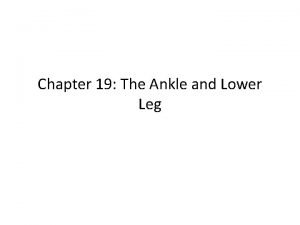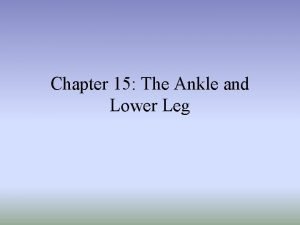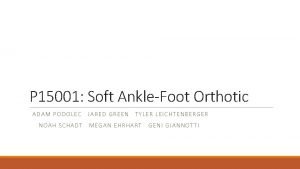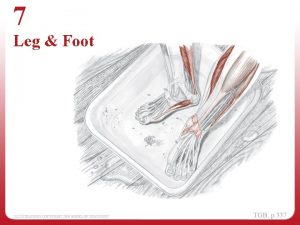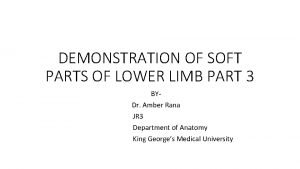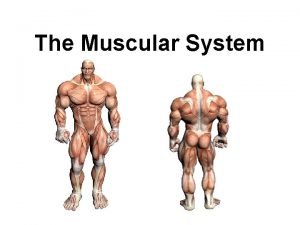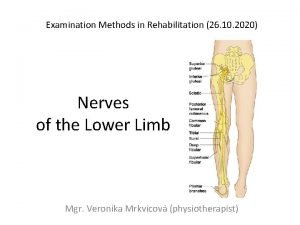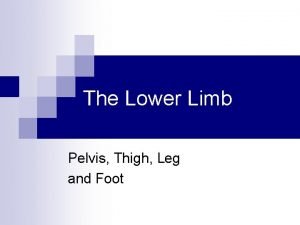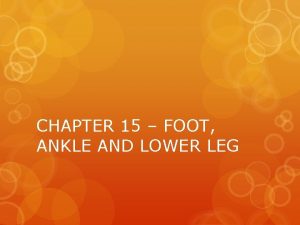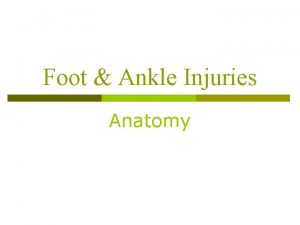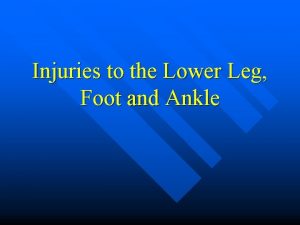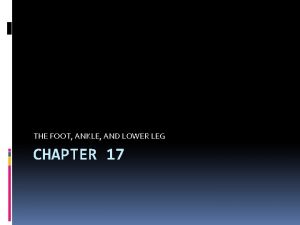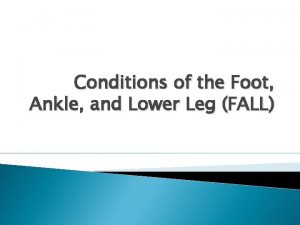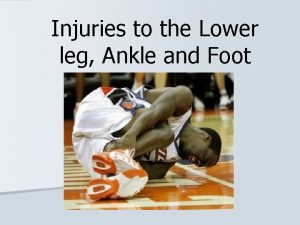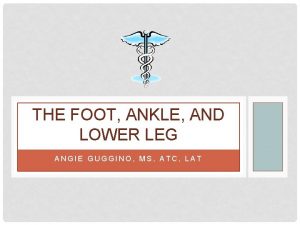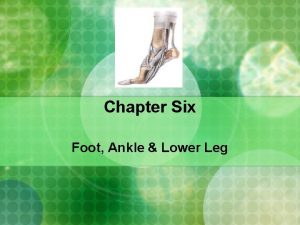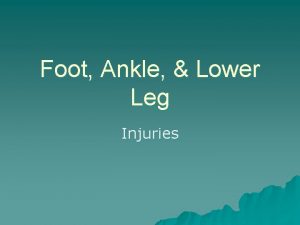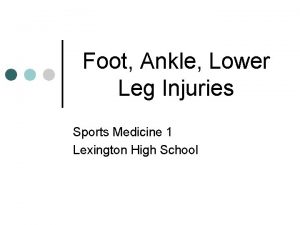The Foot Ankle and Lower Leg FALL Unit


















- Slides: 18

The Foot, Ankle, and Lower Leg (FALL) Unit CHAPTER 14 -15

THE FOOT • THE FOOT HAS STRESSES THAT EXCEED THE DEMANDS PLACED ON ANY OTHER AREA OF THE BODY. • THE FOOT STABILIZES AND SUPPORTS THE REST OF THE BODY WHILE STANDING, WALKING, RUNNING, OR JUMPING. • WHETHER THE IMPACT WITH THE GROUND IS ON THE HEEL, THE BALL OF THE FOOT, OR THE TOE, THE FOOT RESPONDS BY ABSORBING SEVERAL HUNDRED POUNDS OF FORCE UP TO THREE TIMES THE BODY’S WEIGHT.

THE FOOT �The foot is the site of some of the most minor yet some of the most debilitating conditions suffered by athletes. �Examples of these conditions include: - blisters - calluses - athlete’s foot - turf toe - ingrown toenails

THE FOOT �Left untreated, these conditions can develop into serious foot problems, such as: - heel bruises - arch strains - ankle sprains - fractures

ANATOMY OF THE FOOT INDIVIDUALLY, THE PARTS OF THE FOOT (BONES, MUSCLES, LIGAMENTS) ARE WEAK. AS A WHOLE, THE FOOT IS STRONG ENOUGH TO WITHSTAND MOST OF ITS DEMANDS.

ANATOMY OF THE FOOT: ARCHES �The key to the foot’s function is a set of 4 arches, which help in absorbing the impact of walking , running, and jumping. �The arches are called: - metatarsal arch - transverse arch - medial (inner) longitudinal arch - lateral (outer) longitudinal arch

Arches of the Foot

ANATOMY OF THE FOOT: BONES �The feet contain about ¼ of the total number of bones in the body. (There are 206 total bones in an adult human body. ) �Each foot has 26 bones (7 tarsal bones, 5 metatarsal bones, and 14 phalanges) and 38 joints.

ANATOMY OF THE FOOT: BONES �The hind (back) foot is made up of 7 Tarsal bones: - Talus - Calcaneus - Navicular - Cuboid - Medial, Intermediate, and Lateral Cuneiform �The mid-foot region is made up of 5 Metatarsal bones. (1 st-5 th from medial to lateral). �The forefoot (front) is where the toes are located. It is made of 14 bones known as Phalanges. The Hallux (Big Toe) has 2 phalanges. The other toes have 3 each.

Foot Anatomy-Let’s Color!

FUN FACTS about the FALL �Whether the impact is on the heel, the ball of the foot, or the toes, the foot responds by absorbing several hundred pounds of force up to three times your body weight. �The foot may be in a abnormal position. Abnormal positions can create added stress on the FALL and lead to injury. Supination = high arch Pronation=flat foot or fallen arch

ANATOMY OF THE ANKLE • THE TALOCRURAL JOINT (ANKLE JOINT) IS THE MOST COMMONLY INJURED MAJOR JOINT IN AN ATHLETE. THE ANKLE IS ALSO CALLED THE ANKLE MORTISE. IT IS CONSIDERED A MODIFIED HINGE JOINT. • THE TALOCRURAL JOINT OR ANKLE MORTISE IS FORMED BY TWO JOINTS: • • Talocrural joint (tibia, fibula, talus) Subtalar joint (talus and calcaneus)

The Ankle Joint

ANATOMY OF THE ANKLE: BONES �The tibia and the fibula are the two bones of the lower leg; while the talus and the calcaneus are the two largest bones of the foot. �The tibia is the main weight bearing bone of the lower leg. The main reason for this is because of its location on the talus. The tibia is mounted directly over top of the talus and it extends over its medial side. �The fibula is a non-weight bearing bone that extends down the lateral side of the talus forming the lateral malleoli.

ANATOMY OF THE ANKLE: BONES �The malleoli are the two large, bony prominences (bumps) on either side of the ankle. - The medial malleoli is the distal end of the tibia. - The lateral malleoli is the distal end of the fibula.

ANATOMY OF THE ANKLE: LIGAMENTS �After the bony structure, the first line of defense against ankle sprains is the joint’s strong ligamentous support. �Just as with the bony structures, ligaments help the ankle joint be more stable. Remember ligaments hold bones together. �Most of the ligaments involved in supporting the ankle are attached to the rough edges of the malleoli. �The ligaments at the ankle are named for the bones they connect or bring together.

ANATOMY OF THE ANKLE: LIGAMENTS �The ligaments most commonly injured on the lateral side of the ankle are: - Anterior talofibular (ATF) ligament - Calcaneofibular (CF) ligament - Posterior talofibular (PTF) ligament -Anterior tibiofibular ligament -Posterior tibiofibular ligament �The ligaments most commonly injured on the medial side of the ankle are: - Deltoid ligament (anterior tibiotalar, posterior tibiotalar, tibiocalcaneal, and tibionavicular ligaments)

Ligaments of the Ankle
 Chapter 19 worksheet the ankle and lower leg
Chapter 19 worksheet the ankle and lower leg Chapter 15 worksheet the ankle and lower leg
Chapter 15 worksheet the ankle and lower leg Physiology of the foot and ankle
Physiology of the foot and ankle Leg acute angle congruence theorem
Leg acute angle congruence theorem Ankle foot orthoses
Ankle foot orthoses Ankle foot orthosis project
Ankle foot orthosis project Leg and foot topographical views
Leg and foot topographical views Lesser saphenous vein
Lesser saphenous vein Parts of the lower leg
Parts of the lower leg Veins of lower leg
Veins of lower leg Temporalis
Temporalis Forearm muscles
Forearm muscles Lymphatic drainage of umbilicus
Lymphatic drainage of umbilicus Lower leg nerve
Lower leg nerve Extend thigh
Extend thigh Put your right foot in
Put your right foot in A 75 foot building casts an 82 foot shadow
A 75 foot building casts an 82 foot shadow Unit 6 review questions
Unit 6 review questions Which is the si base unit for mass? meter pound gram foot
Which is the si base unit for mass? meter pound gram foot
